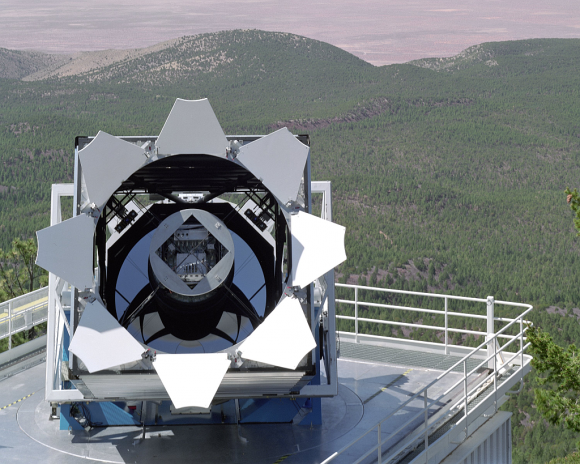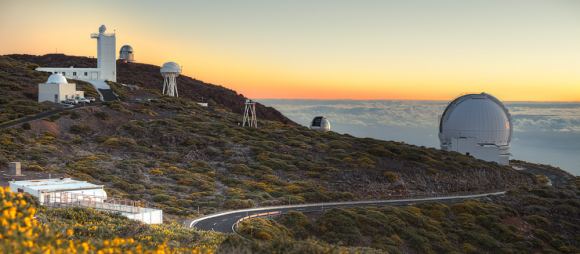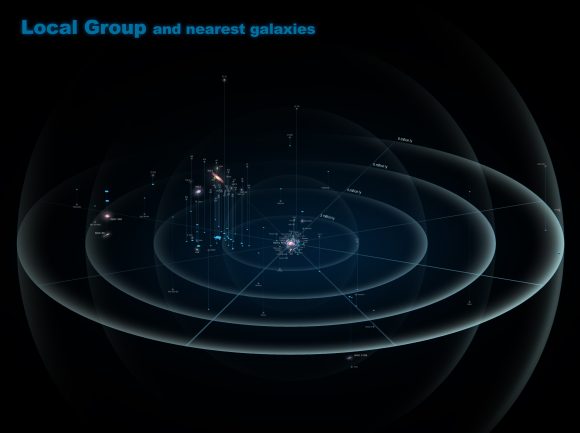One of the greatest challenges of astronomy is locating objects in space that are obscured by the light of nearby, brighter objects. In addition to making extra-solar planets very difficult to directly image, this problem also intrudes on surveys of the local Universe, where astronomers are unable to detect dwarf and isolated galaxies because of all the brighter ones surrounding them.
Because of this, astronomers are unable to do a full inventory of small galaxies in the volume of space surrounding the Milky Way (aka. the Local Volume). However, thanks to the efforts of an amateur astronomer and an international team of scientists, a dwarf spheroidal galaxy was recently discovered lurking behind the Andromeda Galaxy. The discovery of this object, named Donatiello I, could help astronomers learn more about the process of galaxy formation.
The study which describes these findings recently appeared in the journal Astronomy & Astrophysics. The research team was led by David Martínez-Delgado of the Center for Astronomy of Heidelberg University, and included members from the Institute for Research in Fundamental Sciences (IPM) in Tehran, the National Institute for Astrophysics (INAF), the Instituto de Astrofísica de Canarias (IAC), the Special Astrophysical Observatory in Russia, Nuovo Orione, and multiple observatories and universities.

At present, the most widely accepted cosmological model (the Lambda-CDM model) predicts that there are a large number of small dark matter halos in the Local Volume, but it is unclear how many of them are associated with baryonic matter (i.e. star clusters and dwarf galaxies). As such, the ability to do a full inventory of dwarf and isolated galaxies would help resolve this question and allow astronomers to learn more about the history of galaxy formation.
As Dr. Martínez-Delgado told Universe Today via email:
“There is a discrepancy between the observed number of low mass systems in the Local Group and its surroundings and the predicted one in cosmological simulations. A complete census of dwarf galaxies is necessary to understand the actual origin of this problem, as for example, the ingredients and assumptions in the computation of cosmological simulations or the lack of deep observations needed to trace the lowest surface brightness system in the local universe. The census of dwarf galaxies can shed light on key questions on galaxy formation and evolution.”
Unfortunately, creating such an inventory presents many problems, not the least of which is the fact that no large scale, deep imaging surveys have been possible so far. Whereas surveys like the Sloan Digital Sky Survey (SDSS) or the PANoramic Survey Telescope And Rapid Response System (PanSTARRs) survey have been comprehensive, they have surface brightness limits (~24.5-25 magn/parcsec²) that are too high to detect fainter objects.

Another problem is the limits of radio surveys to detect these galaxies, like those being performed by the the Arecibo Legacy Fast Arecibo L-Band Feed Array (ALFALFA) survey. Using this method, astronomers look for hydrogen gas in the spectra lines of distant objects. But since low surface brightness galaxies have a negligible gas content, they do not appear in such surveys.
As Martínez-Delgado explained, this is why the only means to detect them at present is through ultra-deep imaging, which is well-suited to amateur astronomers:
“That is, the only way to find them is by means of ultra-deep imaging in wide areas of the sky. Amateur telescopes can obtain ultra-deep imaging of nearby galaxies or wide sky fields with surface brightness reaching surface brightness limit of 29 magn/arcsec2 or deeper. This provides new chance of discovery for amateurs in the field of galaxy evolution, a topic that was not feasible for amateurs one decade ago. The new generation of large scale surveys (e.g. LSST) will have a tremendous impact on this research topic too.
It was one such amateur astronomer who was responsible for the discovery of the dwarf spheroidal galaxy – an Italian amateur astronomer named Giuseppe Donatiello. Using a 12.7-cm telescope, Donatiello captured a mosaic of deep images of the Andromeda galaxy in 2016, the purpose of which was to detect the stellar streams, satellites galaxies and diffuse streams that had been recently discovered around Andromeda.

It was as he was examining one of these images (on Sept. 3rd, 2016), Donatiello noted the presence of an object located one degree from the star Mirach (beta Andromedae). This object was then confirmed by Martínez-Delgado and his colleagues using archival images from the SDSS, and by follow-up observations made on Nov. 27th, 2016.
These were performing using the 3.58 meter Telescopio Nazionale Galileo (TNG) and the 10.4 meter Gran Telescopio Canarias (GTC), both of which are located at the IAC’s Roque de Los Muchachos Observatory on the island of La Palma, Spain.
This allowed the team to determine the dwarf galaxies distance from Earth, to resolve and study its stars, and confirm that it was indeed a dwarf galaxy in the proximity of the Local Group. This discovery not only demonstrated the effectiveness of ultra-deep surveys conducted by amateur astronomers, it also has immense significance when it comes to the study of low-luminosity dwarf galaxies.
“Donatiello I can be an isolated galaxy that stopped its star formation long time ago,” said Martínez-Delgado. “It is difficult to understand what mechanism was the responsible of this quenched star formation when there is not interaction with any massive host galaxy, like in the case of Donatiello I.”

Because of this discovery, isolated dwarf galaxies could serve as laboratories to test theories of star formation in low-mass systems. This would be of immense use to cosmologists conducting simulations to better understand the history of star formation in the Local Group galaxies, which could help resolve the aforementioned discrepancies between observational astronomy and cosmology.
And as Martínez-Delgado concluded, the discovery of this dwarf galaxy also opens opportunities for further surveys in the region:
“Donatiello I could be one of the brightest members of a large population of isolated, unbound dwarf galaxies that remains undiscovered around the Local Group. A statistical comparison of these observations is extremely important to probe the predictions of state-of-the-art cosmological simulations. I think its discovery must encourage a more systematic survey of this kind of low surface brightness systems with modest instruments.”
This discovery is one of many that demonstrates how improvements in technology and data-sharing are allowing for new opportunities for amateur astronomers. Today, individuals with their own equipment, knowledge and access to scientific databases are able to contribute to the discovery process.
And with next-generation instruments looking farther into the cosmos and in greater detail, we are likely to see more objects that were previously undetectable. These and other discoveries will teach us much about how our Universe came to be.
Further Reading: arXiv

